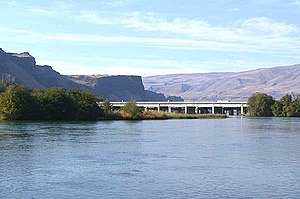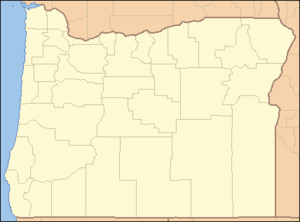Deschutes River (Oregon)
| Deschutes River | |
|
The Deschutes River near its mouth on the Columbia. Pioneers camped on the bluff to the left.
|
|
| Name origin: From Rivière des Chutes, used by early-19th-century fur traders | |
| Country | United States |
|---|---|
| State | Oregon |
| County | Deschutes, Jefferson, Sherman, and Wasco |
| Source | Little Lava Lake |
| - location | Cascade Range, Deschutes County, Oregon |
| - elevation | 4,747 ft (1,447 m) |
| - coordinates | 43°54′33″N 121°45′40″W / 43.90917°N 121.76111°W |
| Mouth | Columbia River |
| - location | between Moody and Biggs Junction, on border between Wasco and Sherman counties, Oregon |
| - elevation | 164 ft (50 m) |
| - coordinates | 45°38′07″N 120°54′52″W / 45.63528°N 120.91444°WCoordinates: 45°38′07″N 120°54′52″W / 45.63528°N 120.91444°W |
| Length | 252 mi (406 km) |
| Basin | 10,500 sq mi (27,200 km2) |
| Discharge | for Moody, 1.4 miles (2.3 km) from mouth |
| - average | 5,824 cu ft/s (200 m3/s) |
| - max | 70,300 cu ft/s (2,000 m3/s) |
| - min | 2,400 cu ft/s (100 m3/s) |
|
Map of the Deschutes watershed
|
|
The Deschutes River /dəˈʃuːts/ in central Oregon is a major tributary of the Columbia River. The river provides much of the drainage on the eastern side of the Cascade Range in Oregon, gathering many of the tributaries that descend from the drier, eastern flank of the mountains. The Deschutes provided an important route to and from the Columbia for Native Americans for thousands of years, and then in the 19th century for pioneers on the Oregon Trail. The river flows mostly through rugged and arid country, and its valley provides a cultural heart for central Oregon. Today the river supplies water for irrigation and is popular in the summer for whitewater rafting and fishing.
The river flows generally north, as do several other large Oregon tributaries of the Columbia River, including the Willamette and John Day.
The headwaters of the Deschutes River are at Little Lava Lake, a natural lake in the Cascade Range approximately 26 miles (42 km) northwest of the city of La Pine. The river flows south into Crane Prairie Reservoir, then into Wickiup Reservoir, from where it heads in a northeasterly direction past the resort community of Sunriver and into the city of Bend, about 170 miles (270 km) from the river mouth.
...
Wikipedia



